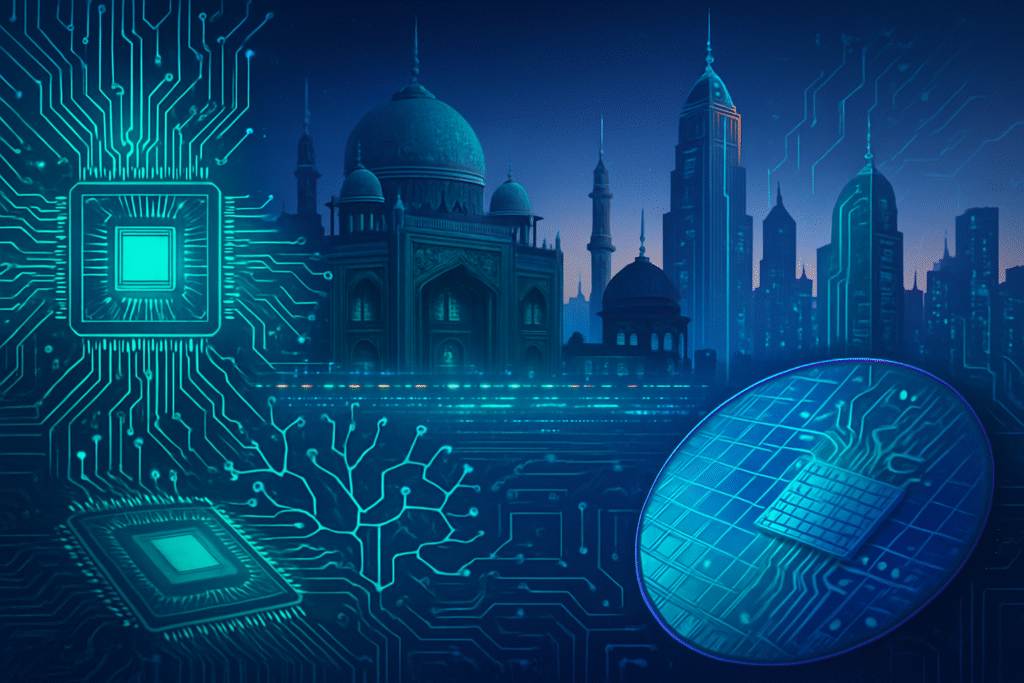
India is aggressively charting a course to become a global powerhouse in semiconductor manufacturing and design, a strategic pivot with profound implications for the future of artificial intelligence and the broader technology sector. Driven by a vision of 'AtmaNirbharta' or self-reliance, the nation is rapidly transitioning from a predominantly design-focused hub to an end-to-end semiconductor value chain player, encompassing fabrication, assembly, testing, marking, and packaging (ATMP) operations. This ambitious push, backed by substantial government incentives and significant private investment, is not merely about economic growth; it's a calculated move to de-risk global supply chains, accelerate AI hardware development, and solidify India's position as a critical node in the evolving technological landscape.
The immediate significance of India's burgeoning semiconductor industry, particularly in the period leading up to October 2025, cannot be overstated. As geopolitical tensions continue to reshape global trade and manufacturing, India offers a crucial alternative to concentrated East Asian supply chains, enhancing resilience and reducing vulnerabilities. For the AI sector, this means a potential surge in global capacity for advanced AI hardware, from high-performance computing (HPC) resources powered by thousands of GPUs to specialized chips for electric vehicles, 5G, and IoT. With its existing strength in semiconductor design talent and a rapidly expanding manufacturing base, India is poised to become an indispensable partner in the global quest for AI innovation and technological sovereignty.
From Concept to Commercialization: India's Technical Leap in Chipmaking
India's semiconductor ambition is rapidly translating into tangible technical advancements and operational milestones. At the forefront is the monumental Tata-PSMC fabrication plant in Dholera, Gujarat, a joint venture between Tata Electronics (NSE: TATAELXSI) and Taiwan's Powerchip Semiconductor Manufacturing Corporation (PSMC). With an investment of ₹91,000 crore (approximately $11 billion), this facility, initiated in March 2024, is slated to begin rolling out chips by September-October 2025, a year ahead of schedule. This 12-inch wafer fab will produce up to 50,000 wafers per month on mature nodes (28nm to 110nm), crucial for high-demand sectors like automotive, power management ICs, display drivers, and microcontrollers – all foundational to embedded AI applications.
Complementing this manufacturing push is the rapid growth in outsourced semiconductor assembly and test (OSAT) capabilities. Kaynes Semicon (NSE: KAYNES), for instance, has established a high-capacity OSAT facility in Sanand, Gujarat, with a ₹3,300 crore investment. This facility, which rolled out India's first commercially made chip module in October 2025, is designed to produce up to 6.3 million chips per day, catering to high-reliability markets including automotive, industrial, data centers, aerospace, and defense. This strategic backward integration is vital for India to reduce import dependence and become a competitive hub for advanced packaging. Furthermore, the Union Cabinet approved four additional semiconductor manufacturing projects in August 2025, including SiCSem Private Limited (Odisha) for India's first commercial Silicon Carbide (SiC) compound semiconductor fabrication facility, crucial for next-generation power electronics and high-frequency applications.
Beyond manufacturing, India is making significant strides in advanced chip design. The nation inaugurated its first centers for advanced 3-nanometer (nm) chip design in Noida and Bengaluru in May 2025. This was swiftly followed by British semiconductor firm ARM establishing a 2-nanometer (nm) chip development presence in Bengaluru in September 2025. These capabilities place India among a select group of nations globally capable of designing such cutting-edge chips, which are essential for enhancing device performance, reducing power consumption, and supporting future AI, mobile computing, and high-performance systems. The India AI Mission, backed by a ₹10,371 crore outlay, further solidifies this by providing over 34,000 GPUs to startups, researchers, and students at subsidized rates, creating the indispensable hardware foundation for indigenous AI development.
Initial reactions from the AI research community and industry experts have been largely positive, albeit with cautious optimism. Experts view the Tata-PSMC fab as a "key milestone" for India's semiconductor journey, positioning it as a crucial alternative supplier and strengthening global supply chains. The advanced packaging efforts by companies like Kaynes Semicon are seen as vital for reducing import dependence and aligning with the global "China +1" diversification strategy. The leap into 2nm and 3nm design capabilities is particularly lauded, placing India at the forefront of advanced chip innovation. However, analysts also point to the immense capital expenditure required, the need to bridge the skill gap between design and manufacturing, and the importance of consistent policy stability as ongoing challenges.
Reshaping the AI Industry Landscape
India's accelerating semiconductor ambition is poised to significantly reshape the competitive landscape for AI companies, tech giants, and startups globally. Domestic players like Tata Electronics (NSE: TATAELXSI) and Kaynes Semicon (NSE: KAYNES) are direct beneficiaries, establishing themselves as pioneers in India's chip manufacturing and packaging sectors. International partners such as PSMC and Clas-SiC Wafer Fab Ltd. are gaining strategic footholds in a rapidly expanding market, while companies like ARM are leveraging India's deep talent pool for advanced R&D. Samsung (KRX: 005930) is also investing to transform its Indian research center into a global AI semiconductor design hub, signaling a broader trend of tech giants deepening their engagement with India's ecosystem.
For major AI labs and tech companies worldwide, India's emergence as a semiconductor hub offers crucial competitive advantages. It provides a diversified and more resilient supply chain, reducing reliance on single geographic regions and mitigating risks associated with geopolitical tensions or natural disasters. This increased stability could lead to more predictable costs and availability of critical AI hardware, impacting everything from data center infrastructure to edge AI devices. Companies seeking to implement a 'China +1' strategy will find India an increasingly attractive destination for manufacturing and R&D, fostering new strategic partnerships and collaborations.
Potential disruption to existing products or services primarily revolves around supply chain dynamics. While a fully mature Indian semiconductor industry is still some years away, the immediate impact is a gradual de-risking of global operations. Companies that are early movers in partnering with Indian manufacturers or establishing operations within the country stand to gain strategic advantages in market positioning, potentially securing better access to components and talent. This could lead to a shift in where future AI hardware innovation and production are concentrated, encouraging more localized and regionalized supply chains.
The market positioning of India itself is dramatically enhanced. From being a consumer and design service provider, India is transforming into a producer and innovator of foundational technology. This shift not only attracts foreign direct investment but also fosters a vibrant domestic ecosystem for AI startups, who will have more direct access to locally manufactured chips and a supportive hardware infrastructure, including the high-performance computing resources offered by the India AI Mission. This strategic advantage extends to sectors like electric vehicles, 5G, and defense, where indigenous chip capabilities are paramount.
Broader Implications and Global Resonance
India's semiconductor ambition is not merely an economic endeavor; it's a profound strategic realignment with significant ramifications for the broader AI landscape and global geopolitical trends. It directly addresses the critical need for supply chain resilience, a lesson painfully learned during recent global disruptions. By establishing domestic manufacturing capabilities, India contributes to a more diversified and robust global semiconductor ecosystem, reducing the world's vulnerability to single points of failure. This aligns perfectly with the global trend towards technological sovereignty and de-risking critical supply chains.
The impacts extend far beyond chip production. Economically, the approved projects represent a cumulative investment of ₹1.6 lakh crore (approximately $18.23 billion), creating thousands of direct and indirect high-tech jobs and stimulating ancillary industries. This contributes significantly to India's vision of becoming a $5 trillion economy and a global manufacturing hub. For national security, self-reliance in semiconductors is paramount, as chips are the bedrock of modern defense systems, critical infrastructure, and secure communication. The 'AtmaNirbharta' drive ensures that India has control over the foundational technology underpinning its digital future and AI advancements.
Potential concerns, however, remain. The semiconductor industry is notoriously capital-intensive, requiring sustained, massive investments and a long gestation period for returns. While India has a strong talent pool in chip design (20% of global design engineers), there's a significant skill gap in specialized semiconductor manufacturing and fab operations, which the government is actively trying to bridge by training 85,000 engineers. Consistent policy stability and ease of doing business are also crucial to sustain investor confidence and ensure long-term growth in a highly competitive global market.
Comparing this to previous AI milestones, India's semiconductor push can be seen as laying the crucial physical infrastructure necessary for the next wave of AI breakthroughs. Just as the development of powerful GPUs by companies like NVIDIA (NASDAQ: NVDA) enabled the deep learning revolution, and the advent of cloud computing provided scalable infrastructure, India's move to secure its own chip supply and design capabilities is a foundational step. It ensures that future AI innovations within India and globally are not bottlenecked by supply chain vulnerabilities or reliance on external entities, fostering an environment for independent and ethical AI development.
The Road Ahead: Future Developments and Challenges
The coming years are expected to witness a rapid acceleration of India's semiconductor journey. The Tata-PSMC fab in Dholera is poised to begin commercial production by late 2025, marking a significant milestone for indigenous chip manufacturing. This will be followed by the operationalization of other approved projects, including the SiCSem facility in Odisha and the expansion of Continental Device India Private Limited (CDIL) in Punjab. The continuous development of 2nm and 3nm chip design capabilities, supported by global players like ARM and Samsung, indicates India's intent to move up the technology curve beyond mature nodes.
Potential applications and use cases on the horizon are vast and transformative. A robust domestic semiconductor industry will directly fuel India's ambitious AI Mission, providing the necessary hardware for advanced machine learning research, large language model development, and high-performance computing. It will also be critical for the growth of electric vehicles, where power management ICs and microcontrollers are essential; for 5G and future communication technologies; for the Internet of Things (IoT); and for defense and aerospace applications, ensuring strategic autonomy. The India AI Mission Portal, with its subsidized GPU access, will democratize AI development, fostering innovation across various sectors.
However, significant challenges need to be addressed for India to fully realize its ambition. The ongoing need for a highly skilled workforce in manufacturing, particularly in complex fab operations, remains paramount. Continuous and substantial capital investment, both domestic and foreign, will be required to build and maintain state-of-the-art facilities. Furthermore, fostering a vibrant ecosystem of homegrown fabless companies and ensuring seamless technology transfer from global partners are crucial. Experts predict that while India will become a significant player, the journey to becoming a fully self-reliant and leading-edge semiconductor nation will be a decade-long endeavor, requiring sustained political will and strategic execution.
A New Era of AI Innovation and Global Resilience
India's determined push into semiconductor manufacturing and design represents a pivotal moment in the nation's technological trajectory and holds profound significance for the global AI landscape. The key takeaways include a strategic shift towards self-reliance, massive government incentives, substantial private investments, and a rapid progression from design-centric to an end-to-end value chain player. Projects like the Tata-PSMC fab and Kaynes Semicon's OSAT facility, alongside advancements in 2nm/3nm chip design and the foundational India AI Mission, underscore a comprehensive national effort.
This development's significance in AI history cannot be overstated. By diversifying the global semiconductor supply chain, India is not just securing its own digital future but also contributing to the stability and resilience of AI innovation worldwide. It ensures that the essential hardware backbone for advanced AI research and deployment is less susceptible to geopolitical shocks, fostering a more robust and distributed ecosystem. This strategic autonomy will enable India to develop ethical and indigenous AI solutions tailored to its unique needs and values, further enriching the global AI discourse.
The long-term impact will see India emerge as an indispensable partner in the global technology order, not just as a consumer or a service provider, but as a critical producer of foundational technologies. What to watch for in the coming weeks and months includes the successful commencement of commercial production at the Tata-PSMC fab, further investment announcements in advanced nodes, the expansion of the India AI Mission's resources, and continued progress in developing a skilled manufacturing workforce. India's semiconductor journey is a testament to its resolve to power the next generation of AI and secure its place as a global technology leader.
This content is intended for informational purposes only and represents analysis of current AI developments.
TokenRing AI delivers enterprise-grade solutions for multi-agent AI workflow orchestration, AI-powered development tools, and seamless remote collaboration platforms.
For more information, visit https://www.tokenring.ai/.





